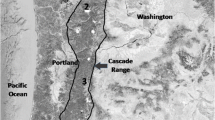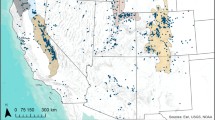Abstract
Lakes in the Cascade Mountains of the Pacific Northwest are among the most dilute in the world and second only to Sierra Nevada lakes in the United States. High precipitation quantities, unreactive bedrock minerals, and generally thin soil development contribute to the dilute chemical composition of Cascade lakes. The principal data set used as the basis for evaluating the status of the lakes with regard to acidic deposition was the Western Lake Survey (WLS), a statistically designed survey of low ANC lakes conducted by the U.S. EPA as part of the National Acid Precipitation Assessment Program (NAPAP). Other data sets contributed either to the baseline chemical data set or to the evaluation of processes affecting lake water composition.
Based on the WLS data set, Cascade lakes have the following overall population characteristics. Median values of key chemical parameters are: pH, 7.2; ANC, 102 µeq L−1; SO42−, 10.0 µeq L−1; sum of base cations, 127 µeq L−1; Ca2+, 70.5 µeq L−1, and DOC, 101 µmol L−1. Eighty-two percent of Cascade lakes have ANC ≤ 200 lieq L−1, 94% have SO42− ≤ 50 µeq L−1, and 78% have pH < 7.5.
Six geomorphic subregions of the Cascade Mountains along a 1,000-km north-south transect were considered. Based on population medians, California Cascade lakes had the most dilute ionic composition and the lowest ANC, and northern Washington Cascade lakes the highest values of the two parameters, with a generally increasing gradient of most chemical parameters proceeding from south to north. Sulfate was very low in Oregon Cascade lakes and highest in the middle Washington Cascades, which receive deposition from anthropogenic sources in the Puget Sound urban complex.
Seasonal trends in Cascade lake chemical composition are dominated by the relatively rapid dilution effect of snowmelt in the late spring to early summer period, followed by a gradual increase in concentrations throughout the remainder of the year. Variations in composition range from 10% to 20% of the mean for lakes with long hydrologic residence times to 100% to 300% of the mean for lakes with short hydrologic residence times. Total dissolved Al, although very low, can double from July to October, with the major increase attributable to the organically complexed fraction. Minor pulses of acid anions may occur during the snowmelt period, but changes in ANC due to acidification have not been clearly demonstrated.
Access this chapter
Tax calculation will be finalised at checkout
Purchases are for personal use only
Preview
Unable to display preview. Download preview PDF.
Similar content being viewed by others
Editor information
Editors and Affiliations
Rights and permissions
Copyright information
© 1991 Springer-Verlag New York Inc.
About this chapter
Cite this chapter
Nelson, P.O. (1991). Cascade Mountains. In: Charles, D.F. (eds) Acidic Deposition and Aquatic Ecosystems. Springer, New York, NY. https://doi.org/10.1007/978-1-4613-9038-1_22
Download citation
DOI: https://doi.org/10.1007/978-1-4613-9038-1_22
Publisher Name: Springer, New York, NY
Print ISBN: 978-1-4613-9040-4
Online ISBN: 978-1-4613-9038-1
eBook Packages: Springer Book Archive




